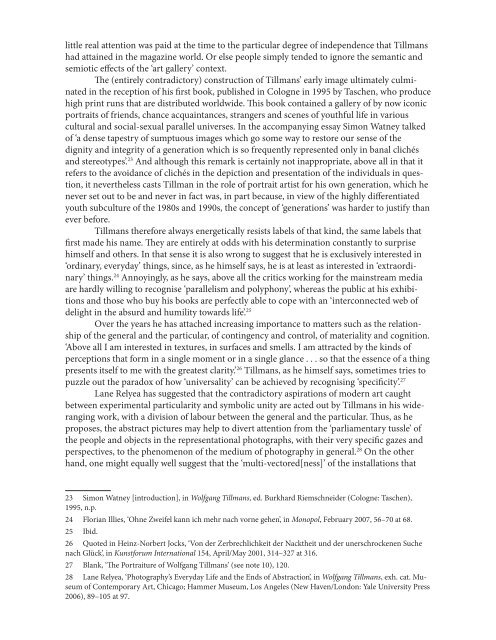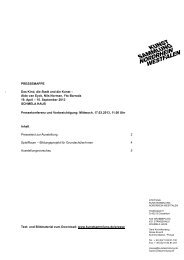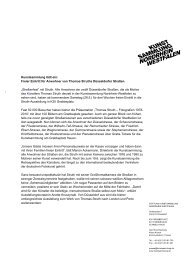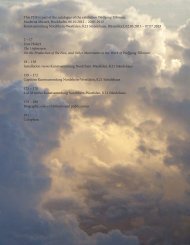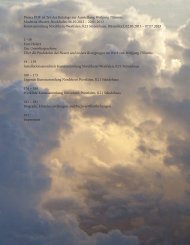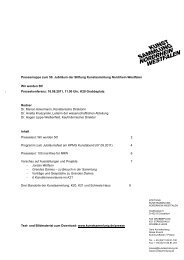Download online catalog (pdf)
Download online catalog (pdf)
Download online catalog (pdf)
You also want an ePaper? Increase the reach of your titles
YUMPU automatically turns print PDFs into web optimized ePapers that Google loves.
little real attention was paid at the time to the particular degree of independence that Tillmans<br />
had attained in the magazine world. Or else people simply tended to ignore the semantic and<br />
semiotic effects of the ‘art gallery’ context.<br />
The (entirely contradictory) construction of Tillmans’ early image ultimately culminated<br />
in the reception of his first book, published in Cologne in 1995 by Taschen, who produce<br />
high print runs that are distributed worldwide. This book contained a gallery of by now iconic<br />
portraits of friends, chance acquaintances, strangers and scenes of youthful life in various<br />
cultural and social-sexual parallel universes. In the accompanying essay Simon Watney talked<br />
of ‘a dense tapestry of sumptuous images which go some way to restore our sense of the<br />
dignity and integrity of a generation which is so frequently represented only in banal clichés<br />
and stereotypes’. 23 And although this remark is certainly not inappropriate, above all in that it<br />
refers to the avoidance of clichés in the depiction and presentation of the individuals in question,<br />
it nevertheless casts Tillman in the role of portrait artist for his own generation, which he<br />
never set out to be and never in fact was, in part because, in view of the highly differentiated<br />
youth subculture of the 1980s and 1990s, the concept of ‘generations’ was harder to justify than<br />
ever before.<br />
Tillmans therefore always energetically resists labels of that kind, the same labels that<br />
first made his name. They are entirely at odds with his determination constantly to surprise<br />
himself and others. In that sense it is also wrong to suggest that he is exclusively interested in<br />
‘ordinary, everyday’ things, since, as he himself says, he is at least as interested in ‘extraordinary’<br />
things. 24 Annoyingly, as he says, above all the critics working for the mainstream media<br />
are hardly willing to recognise ‘parallelism and polyphony’, whereas the public at his exhibitions<br />
and those who buy his books are perfectly able to cope with an ‘interconnected web of<br />
delight in the absurd and humility towards life’. 25<br />
Over the years he has attached increasing importance to matters such as the relationship<br />
of the general and the particular, of contingency and control, of materiality and cognition.<br />
‘Above all I am interested in textures, in surfaces and smells. I am attracted by the kinds of<br />
perceptions that form in a single moment or in a single glance . . . so that the essence of a thing<br />
presents itself to me with the greatest clarity.’ 26 Tillmans, as he himself says, sometimes tries to<br />
puzzle out the paradox of how ‘universality’ can be achieved by recognising ‘specificity’. 27<br />
Lane Relyea has suggested that the contradictory aspirations of modern art caught<br />
between experimental particularity and symbolic unity are acted out by Tillmans in his wideranging<br />
work, with a division of labour between the general and the particular. Thus, as he<br />
proposes, the abstract pictures may help to divert attention from the ‘parliamentary tussle’ of<br />
the people and objects in the representational photographs, with their very specific gazes and<br />
perspectives, to the phenomenon of the medium of photography in general. 28 On the other<br />
hand, one might equally well suggest that the ‘multi-vectored[ness]’ of the installations that<br />
23 Simon Watney [introduction], in Wolfgang Tillmans, ed. Burkhard Riemschneider (Cologne: Taschen),<br />
1995, n.p.<br />
24 Florian Illies, ‘Ohne Zweifel kann ich mehr nach vorne gehen’, in Monopol, February 2007, 56–70 at 68.<br />
25 Ibid.<br />
26 Quoted in Heinz-Norbert Jocks, ‘Von der Zerbrechlichkeit der Nacktheit und der unerschrockenen Suche<br />
nach Glück’, in Kunstforum International 154, April/May 2001, 314–327 at 316.<br />
27 Blank, ‘The Portraiture of Wolfgang Tillmans’ (see note 10), 120.<br />
28 Lane Relyea, ‘Photography’s Everyday Life and the Ends of Abstraction’, in Wolfgang Tillmans, exh. cat. Museum<br />
of Contemporary Art, Chicago; Hammer Museum, Los Angeles (New Haven/London: Yale University Press<br />
2006), 89–105 at 97.


